
Looking for How to can your own homemade canned pickled carrots (complete directions with photos ) in 2025? Scroll down this page and follow the links. And if you bring home some fruit or vegetables and want to can, freeze, make jam, salsa or pickles, see this page for simple, reliable, illustrated canning, freezing or preserving directions. There are plenty of other related resources, click on the resources dropdown above. If you are having a hard time finding canning lids, I've used these, and they're a great price & ship in 2 days.
If you have questions or feedback, please let me know! There are affiliate links on this page. Read our disclosure policy to learn more.
How to can your own homemade canned pickled carrots (complete directions with photos )
How to Make Homemade Canned Pickled Carrots
Making and canning your own pickled carrots is quite easy, safe and inexpensive. You can do it with basic equipment already in your kitchen - you just need a canning pot. And thanks to the vinegar in pickled carrots, you can use either a plain open water bath pot or a Pressure Canner (which will also let you can low acid vegetables!)
So, here's how to can pickled carrots! The directions are complete with instructions in easy steps and completely illustrated. In the winter when you open a jar, the pickled carrots will taste MUCH better than any store-bought canned pickled carrots!
Prepared this way, the jars have a shelf life of about 12 months, and aside from storing in a cool, dark place, require no special attention.
Directions for Making Canned Pickled Carrots
Ingredients and Equipment
|
|
Recipe and Directions
Yield: About 4 pint jars
Step 1 - Selecting the carrots
The most important step! You need carrots that are FRESH and crisp. Limp, old carrots will make nasty tasting canned carrots. Guests will probably throw them at you.. Select firm, crisp carrots. Remove and discard any soft, diseased, spotted and chewed up carrots.
How many carrots and where to get them
You can grow your own, pick your own, or buy them at the grocery store. About 7 pounds of 2- to 21/2-inch diameter carrots makes about 8 pints of pickled carrots. I wouldn't use canned carrots; what's the point: Most of the flavor is gone from them, and you can always get fresh carrots.
Step 2 - Prepare the jars and canner
 Wash
the jars and lids
Wash
the jars and lids
This is a good time to get the jars ready! The dishwasher is fine for the jars; especially if it has a "sanitize" cycle. Otherwise put the jars in boiling water for 10 minutes. I just put the lids in a small pot of almost boiling water for 5 minutes, and use the magnetic "lid lifter wand" (available from target, other big box stores, and often grocery stores; and available online - see this page) to pull them out.
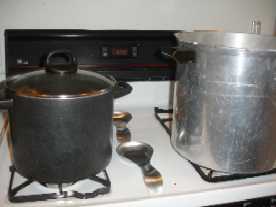
Get the canner heating up
Rinse out your canner, put the rack in the bottom, and fill it with hot tap water. (Of course, follow the instruction that came with the canner, if they are different). Put it on the stove over low heat just to get it heating up for later on.
Step 3 -Wash the carrots!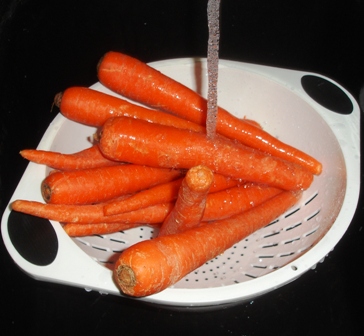
I'm sure you can figure out how to scrub the carrots in plain cold or lukewarm water using your hands or a vegetable brush.
Step 4 - Peel the carrots and cut into smaller pieces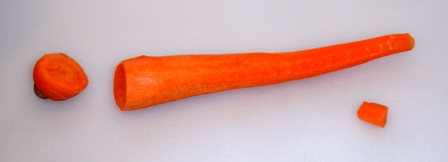
Peel and slice into rounds cuts that are 1/2-inch thick (approximately).
Step 5 - Wash again
Rinse the carrots again in cold water
Step 6 - Make the Pickling Solution
Combine the vinegar, salt, sugar (or Stevia (in a prepared form like Truvia, it measures same as sugar; if you use another form, you will need do your own conversion) - or Splenda, if you prefer, if you need a no-sugar version) and fresh water in a large pot (8-quart or larger).
Step 7 - Heat the pickling solution
Bring the solution to a boil. Then keep it boiling gently for 3 minutes.
Step 8a - Add the carrots and simmer
Add
the carrots and bring it back to a boil. Reduce heat to a simmer
and heat until the
carrots are half-cooked (about 10 minutes).
Step 8b - Prepare the jars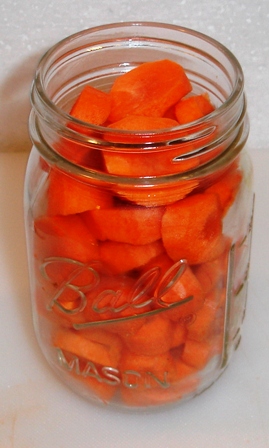
While the carrots are cooking, put 2 teaspoons mustard seed and 1 teaspoon celery seed in the bottom of each clean, hot pint jar.
Step 9 - Packing the carrots in the canning jars
This is called "hot packing"! Fill the jars with the hot carrots, leaving 1-inch headspace. Pack the jars fairly tightly, but be sure to leave at least 1/2 inch, preferably 1-inch of space at the TOP of the jar. That is called "headspace" and is needed for expansion during heating in the water bath.
Step 10 - Pour boiling cooking liquid into each packed jar
Use a ladle or pyrex measuring cup to carefully fill each packed jar with the hot vinegar solution (pickling liquid), again allowing 1/2 to 1-inch headspace. The carrots should be covered and there should still be 1 inch of airspace left in the top of each jar. Be careful not to burn yourself, (or anyone else - children should be kept back during this step!)
Remove air bubbles (by sliding a dull knife inside the jars and/or gently jostling them) and adjust headspace if needed.
Step 11 - Put the lids and rings on
Wipe rims of jars with a dampened, clean paper towel and put the lids on each jar. Seal them by putting a ring on and screwing it down snugly (but not with all your might, just "snug").
Step 12 - Put the jars in the canner and the lid on the canner
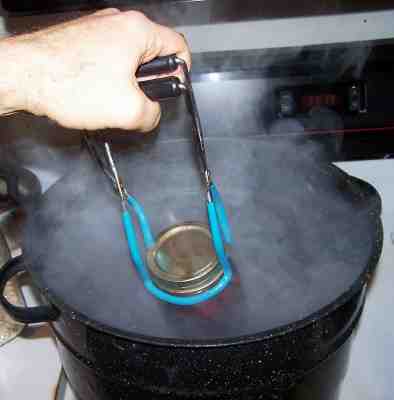 Using
the jar tongs, put the jars on the rack in the canner. Make sure
the tops of the jars are covered by at least 1 inch of water.
Using
the jar tongs, put the jars on the rack in the canner. Make sure
the tops of the jars are covered by at least 1 inch of water.
Step 13 - Process for 15 minutes*
The chart below will help you determine the right processing time and pressure, if you have a different type of canner, or are above sea level. For most people, using a plain open water bath canner, the time will be 15 minutes. You can use either a plain water bath canner OR a pressure canner, since the vinegar adds so much acidity (if you can vegetables other than tomatoes without adding vinegar, you must use a pressure canner).
*Recommended Processing times For Pickled Carrots in A Boiling Water (Open) Bath Canner |
||||
|
PROCESS TIMES (MIN) AT ALTITUDES OF: |
||||
| Style of Pack | Jar Size | 0-1000 ft. | 1001-6000 ft. | Above 6000 ft. |
| Hot | Pints or Quarts | 15 | 20 | 25 |
Step 14 - Remove the jars
Lift
the jars out of the water and let them cool on a wooden cutting board or
a towel, without touching or bumping them in a draft-free place
(usually takes overnight), here they won't be bumped. You can then
remove the rings if you like, but if you leave them on, at least loosen
them quite a bit, so they don't rust in place due to trapped moisture.
Once the jars are cool, you can check that they are sealed verifying
that the lid has been sucked down. Just press in the center, gently,
with your finger. If it pops up and down (often making a popping sound),
it is not sealed. If you put the jar in the refrigerator right away, you
can still use it. Some people replace the lid and reprocess the jar,
then that's a bit iffy. If you heat the contents back up, re-jar them
(with a new lid) and the full time in the canner, it's usually ok.
You're done! Now, just let the carrots sit in processed jars for 3 to 5 days before consuming for the flavor to develop!
Other Equipment:
- Jar lifting tongs to pick up hot jars
- Lid lifter - to remove lids from the pot of boiling water (sterilizing )
- Lids- disposable - you may only use them once
- Ring - holds the lids on the jar until after the jars cool - then you remove them, save them and reuse them
- Canning Jar funnel - to fill the jars
Frequently Asked Questions
Q. Is it safe to can pickled carrots in a traditional water bath? If so how long do you do process them?
A. Yes! Pickled vegetables have added vinegar which adds acid and lowers the pH, making it safe to can in a water bath canner,(or a Pressure Canner)
Plain canned carrots (not pickled) require a pressure canner. Quoting from the Ohio State University Extension's Fact Sheet:
"Pressure canning is the only safe method for home canning vegetables. Clostridium botulinum is the bacterium that causes botulism food poisoning in low-acid foods, such as vegetables. The bacterial spores are destroyed only when the vegetables are processed in a Pressure Canner at 240 degrees Fahrenheit (F) for the correct amount of time.Clostridium botulinum is the bacterium commonly found in vegetables and meats. It is harmless until it finds itself in a moist, low-acid, oxygen-free environment or a partial vacuum. Under these conditions, the bacterium can grow and produce toxins dangerous to people and animals.
Do not process (low acid) vegetables using the boiling water bath because the botulinum bacteria can survive that method.
Can fruits and vegetables be canned without heating if aspirin is used? No. Aspirin should not be used in canning. It cannot be relied on to prevent spoilage or to give satisfactory products. Adequate heat treatment is the only safe procedure.Is it safe to can carrots in a boiling water bath if vinegar is used? No. Recommended processing methods must be used to assure safety. Recommended processing times cannot be shortened if vinegar is used in canning fresh vegetables. (This does not refer to pickled vegetables.)
Salt and sugar are not preservatives for vegetables: they are added to stabilize and improve flavor, but will not prevent spoilage.
Salicylic acid is also NOT a preservative. The University of Illinois reports:
Using Aspirin for Canning
Several years ago, a recipe circulated using aspirin to acidify tomatoes and carrots for canning. Aspirin is not recommended for canning. While it contains salicylic acid, it does not sufficiently acidify tomatoes or carrots for safe hot water bath canning. carrots are low acid foods and may only be processed safely in a Pressure Canner. Lemon juice or vinegar is recommended to acidify tomato products for safe water bath processing.
Think of it like smoking. We all know someone who smoke their entire life and lived to be 90. But the cemeteries are filled with the vast majority who didn't. You will hear people say "my grandmother did it that way for 20 years". But of course, the people who died from food poisoning aren't around and often didn't have descendants to tell their tale...
Picking Tips
[General picking tips and a guide to each fruit and vegetable] [How
much do I need to pick?
(Yields - how much raw makes how much cooked or frozen)] [Selecting
the right varieties to pick] [All
about apple varieties - which to pick and why!] [Picking tips for Vegetables]
[ Strawberry picking tips]
[ Blueberries picking tips]
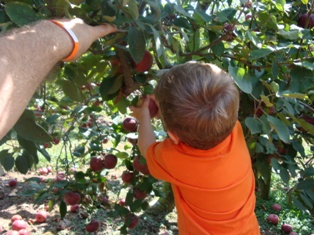
Illustrated Canning, Freezing, Jam Instructions and Recipes
[ All About Home Canning, Freezing and Making Jams, Pickles, Sauces, etc. ] [FAQs - Answers to common questions and problems] [Recommended books about home canning, jam making, drying and preserving!] [Free canning publications to download and print]
Home Canning Kits
This is the same type of standard canner that my grandmother used to make everything from applesauce to jams and jellies to tomato and spaghetti sauce. This complete kit includes everything you need and lasts for years: the canner, jar rack, jar grabber tongs, lid lifting wand, a plastic funnel, labels, bubble freer. It's much cheaper than buying the items separately. You'll never need anything else except jars & lids (and the jars are reusable)! There is also a simple kit with just the canner and rack, and a pressure canner, if you want to do vegetables (other than tomatoes). To see
more canners, of different styles, makes and prices, click here!
Don't forget the Ball Blue Book!

